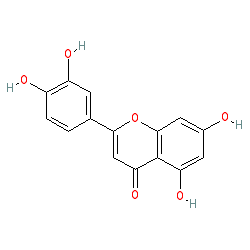|
Compound class:
Natural product or derivative
Comment: Luteolin is a flavone, a type of flavonoid, naturally occuring in a variety of plants. It has antimalarial activity, inhibiting the growth of P. falciparum during the intraerythrocytic stages of the parasite's lifecycle [1].
Ligand Activity Visualisation ChartsThese are box plot that provide a unique visualisation, summarising all the activity data for a ligand taken from ChEMBL and GtoPdb across multiple targets and species. Click on a plot to see the median, interquartile range, low and high data points. A value of zero indicates that no data are available. A separate chart is created for each target, and where possible the algorithm tries to merge ChEMBL and GtoPdb targets by matching them on name and UniProt accession, for each available species. However, please note that inconsistency in naming of targets may lead to data for the same target being reported across multiple charts. ✖ |
|
|||||||||||||||||||||||||||||||||||
| References |
|
1. Lehane AM, Saliba KJ. (2008)
Common dietary flavonoids inhibit the growth of the intraerythrocytic malaria parasite. BMC Res Notes, 1: 26. [PMID:18710482] |
|
2. Roland WS, van Buren L, Gruppen H, Driesse M, Gouka RJ, Smit G, Vincken JP. (2013)
Bitter taste receptor activation by flavonoids and isoflavonoids: modeled structural requirements for activation of hTAS2R14 and hTAS2R39. J Agric Food Chem, 61 (44): 10454-66. [PMID:24117141] |








